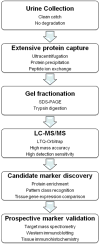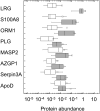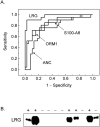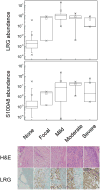Discovery and validation of urine markers of acute pediatric appendicitis using high-accuracy mass spectrometry
- PMID: 19556024
- PMCID: PMC4422167
- DOI: 10.1016/j.annemergmed.2009.04.020
Discovery and validation of urine markers of acute pediatric appendicitis using high-accuracy mass spectrometry
Abstract
Study objective: Molecular definition of disease has been changing all aspects of medical practice, from diagnosis and screening to understanding and treatment. Acute appendicitis is among many human conditions that are complicated by the heterogeneity of clinical presentation and shortage of diagnostic markers. Here, we sought to profile the urine of patients with appendicitis, with the goal of identifying new diagnostic markers.
Methods: Candidate markers were identified from the urine of children with histologically proven appendicitis by using high-accuracy mass spectrometry proteome profiling. These systemic and local markers were used to assess the probability of appendicitis in a blinded, prospective study of children being evaluated for acute abdominal pain in our emergency department. Tests of performance of the markers were evaluated against the pathologic diagnosis and histologic grade of appendicitis.
Results: Test performance of 57 identified candidate markers was studied in 67 patients, with median age of 11 years, 37% of whom had appendicitis. Several exhibited favorable diagnostic performance, including calgranulin A (S100-A8), alpha-1-acid glycoprotein 1 (orosomucoid), and leucine-rich alpha-2-glycoprotein (LRG), with the receiver operating characteristic area under the curve and values of 0.84 (95% confidence interval [CI] 0.72 to 0.95), 0.84 (95% CI 0.72 to 0.95), and 0.97 (95% CI 0.93 to 1.0), respectively. LRG was enriched in diseased appendices, and its abundance correlated with severity of appendicitis.
Conclusion: High-accuracy mass spectrometry urine proteome profiling allowed identification of diagnostic markers of acute appendicitis. Usage of LRG and other identified biomarkers may improve the diagnostic accuracy of clinical evaluations of appendicitis.
Copyright 2009. Published by Mosby, Inc.
Figures




References
-
- Addiss DG, Shaffer N, Fowler BS, et al. The epidemiology of appendicitis and appendectomy in the United States. Am J Epidemiol. 1990 Nov;132(5):910–925. - PubMed
-
- Rappaport WD, Peterson M, Stanton C. Factors responsible for the high perforation rate seen in early childhood appendicitis. Am Surg. 1989 Oct;55(10):602–605. - PubMed
-
- Williams N, Bello M. Perforation rate relates to delayed presentation in childhood acute appendicitis. J R Coll Surg Edinb. 1998 Apr;43(2):101–102. - PubMed
-
- Rao PM, Rhea JT, Novelline RA, et al. Effect of computed tomography of the appendix on treatment of patients and use of hospital resources. N Engl J Med. 1998 Jan 15;338(3):141–146. - PubMed
Publication types
MeSH terms
Substances
Grants and funding
LinkOut - more resources
Full Text Sources
Other Literature Sources
Medical
Miscellaneous

